An Introduction to Sauce: A Roundup of Flavor
A wide assortment of sauces have become a fundamental tool in my kitchen, making delicious meals easy, and appealing to our elderly parents.

Now that Rich and I live with his parents, I have had to gradually change some of my cooking style, and recipes. Some of this, of course, is just personal preference – they’re not as fond of rice as we are, for instance, so I use it less and potatoes more. (Luckily we all like sweet potatoes, and it’s easy to get terrific ones here in North Carolina!) But – unsurprisingly, given that they are in their nineties – some of it is caused by physical changes or actual medical problems.
As we grow older most of us lose some of our ability to taste. Both changes to the actual taste buds,and more often, changes in the sense of smell can cause this (as can side effects of some illnesses and some medications.) Over time, food just seems to lose flavor, which is one reason some older people start using more salt than they had, for instance, or other seasoning, while others simply lose their appetite. Barbara has lost some appetite, and we can have trouble getting her to eat enough good nutritious food.
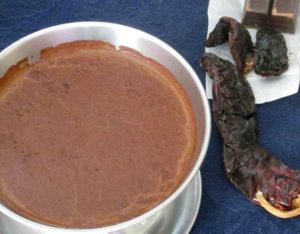
I discovered, though, almost by accident, that she enjoys foods with highly seasoned sauce – curries of all kinds, enchiladas, paprikash… Originally we assumed that was all about the added flavor – she can taste the spices and definitely enjoys moderate heat – but then we realized there was a second issue – and were able to get some professional advice.
Elderly people often develop some difficulty swallowing. It can be a medical condition called dysphagia, and in the more extreme forms people may need to eat only pureed food. Fortunately we are not dealing with anything that serious! But – think of a peanut butter sandwich, with no jam or fruit, on a sandwich made on a roll. Very dry, right? You’ll find yourself chewing, and chewing, and it sticks to the roof of your mouth, and… Other food can become equally difficult.
The best way to solve that problem is to add moisture. The jelly on the iconic PB&J sandwich, to return to the example, adds moisture. Milk with cereal. Gravy on your mashed potatoes. And sauce all over everything… I had made sauce and gravy all along, just for the flavor, so eating it more often is no hardship.
In classic French cooking, they speak of Mother Sauces, also known as Great Sauces – classic, basic recipes that form the base for many variations. I don’t limit myself to the French sauces, because the rest of the world makes many other kinds, but I like the concept of a base sauce and variations. You can add seasoning, change the liquid, completely change the flavor. You can thin a sauce to make soup, or thicken it more to make a spread. And often, you don’t even think of it as a sauce, but as the binder that holds other food together – a casserole, for instance – or a seasoning – how often do we think of mayonnaise, mustard, and ketchup as sauce? But they are…
Types of Sauce
Roux
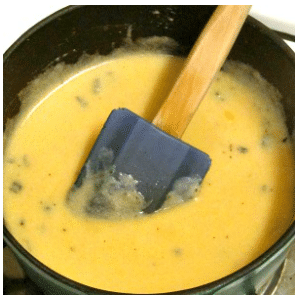
I can’t tell you how glad I have been that I already made gluten free sauce with my Roux Cubes! I could make sauce and gravy easily and quickly right before serving dinner, without having to worry about finding something I can eat. Or something they can eat… If I make it myself I avoid gluten, yes, but also can control salt, avoid hydrogenated fat, avoid the remarkable collection of additives one finds in some commercial packages. (Not that I’m a purist – I have often said that if a jar of commercial sauce lets you get an otherwise homemade dinner on the table instead of stopping at the drive through, it is a worthy ingredient!) And I can flavor it as I want to. (And you don’t have to make it gluten free, if you don’t need to – my first version used wheat flour.)
When I first wrote about the Roux Cubes I also gave you a recipe for Simple White Sauce, and instructions to use it in a casserole. That sauce then forms the base for cheese sauce, and even for soup! Or use the same technique with meat stock, mushroom broth, or the liquid in the pan after you cook something – and you have gravy.
Starch Thickened Sauce
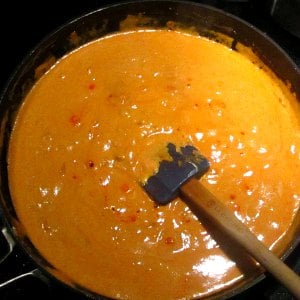
Well, you can use flour in a slurry, without making a roux. I don’t think it works as well in most recipes, but there are exceptions – Paprikash, for instance, in which you stir flour into sour cream and add it to the cooking liquid at the end to make your sauce. Or you coat food in flour and brown that, then add liquid, which is in turn thickened by the flour – a common technique for stew, and some Chinese stir fries.
But this is always the way to use cornstarch or arrowroot – also an Asian technique… Cook the food, then add a slurry of starch at the last minute. Quite useful, too, if you open the slow cooker and realize everything is wetter than you expected…
And that can of condensed Cream of Something Soup you may have poured into a casserole or slow cooker? Most likely, it falls into this category.
Emulsion Sauces
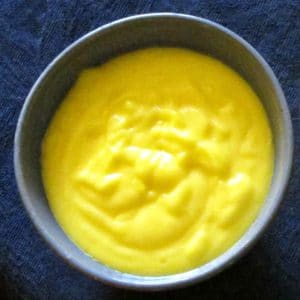
So maybe you don’t think of mayonnaise as sauce. You spread it on sandwiches, add it to casseroles, use it as the base of dips (oh, yes – dips are sauces…) But in fact, it’s one of the French Mother Sauces, in a category called Emulsion sauces. Mayonnaise and Hollandaise both use egg yolk to emulsify fat (traditionally olive oil in one, butter in the other) to make a thick sauce. And again, you can take the base recipe and vary it – Remoulade, for instance, or salad dressing.
Fruit or Vegetables
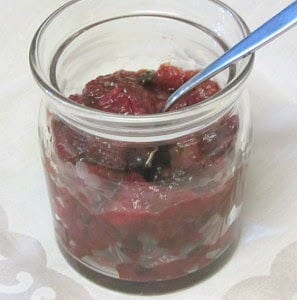
Fine French cooks considers Tomato sauce to be another of their classics – but they hardly hold an exclusive claim to it! Surely we’ve all had some form of tomato based spaghetti sauce, homemade or from a jar. But do you think of applesauce in the same category? Take a fresh, juicy fruit or vegetable, simmer it to thicken it, add seasonings as you will… and you have everything from ketchup to Cranberry Sauce to Sorrel Sauce…
Legumes, Nuts, or Seeds
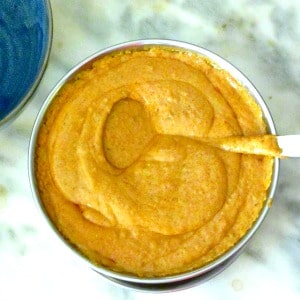
Now we have left the French Mother sauces, though some of these are used in French cooking, and moved into a wide variety of foods made around the world. The basic condiment on your table is mustard – the ground seed itself thickens the sauce, and a dab of it can help emulsify oil and vinegar salad dressing. Peanuts have a similar quality, and are used in mole and other sauces – and I’ve used them here for a few sauces and as the binder for granola.
Asia gives us myriad uses for beans. East to West – soy beans become bean paste, miso, soy sauce (none of which do I plan to make at home… though I certainly do use commercial versions.) On the Indian Subcontinent lentils of all kinds are cooked into dal, which can be used as sauce. Closer to the Mediterranean we have hummus, which can be made as a thick spread or a thin sauce or dip… And returning to seeds, sesame seeds are ground into sauce in all these cultures as well, and sometimes served with the beans. (Authentic Hummus bi Tahini is a loose dip made of chickpeas and sesame seeds, which people scoop up with bread.) And again – the difference between soup, sauce, and spread is almost entirely the level of liquid. The technique is the same.
And More…
Other than a nod to soy sauce and miso I have not touched fermented sauces such as fish sauce. I do not have meat sauce as a category, as it usually fits into one of the others, simply made with meat as an ingredient. But each basic sauce has almost infinite variations, and two can be combined into compound sauce to give you even more (a little tomato paste in your beef gravy, for example…) I have not scratched the surface.
What does this mean for the home cook, especially the one working through her own limitations, or giving all his energy to caring for someone else (or both?) Well, if you have the specific issues we have with making food appealing or easy to eat, sauce can be your lifesaver – but even if you don’t…
Sauce makes the meal. Take some boneless chicken, for example, cut it up and toss it into a pan (maybe with onions, if you feel like it) start to cook it. Now what do you do? Add paprika, sour cream and flour – paprikash (or a version thereof…) Add garlic chili paste, mix well, braise in a little water with soy sauce, thicken it with cornstarch. Braise in a little broth with sage and thyme, use a roux cube to thicken – chicken and gravy. Add a can of tomato puree, basil and oregano, crushed red pepper. Saute the chicken with finely chopped onion and curry powder, add water to braise. Five totally different meals, each can be done in about 20-30 minutes (depending on how much chicken you need to cut up, as much as anything else.) Not bad…
Easier still – keep one or two kinds of sauce (a peanut sauce, for instance) on hand, or use a roux cube to pull one together in a few minutes to ladle over already cooked food, for an instant meal. Put out a few condiments – mustard, applesauce – and everyone will be delighted!
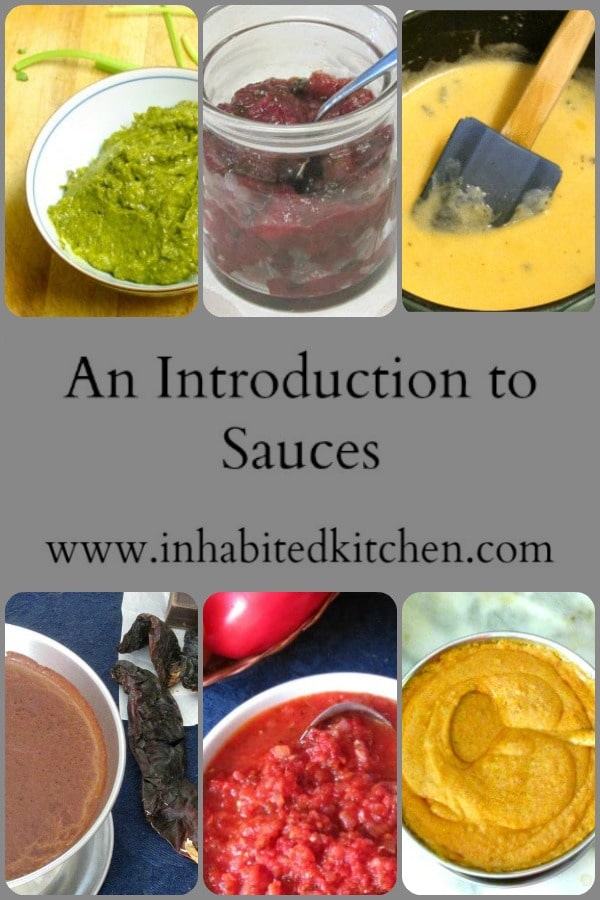

I think that a good sauce can make an okay meal into something great. It’s the difference between eating and dining in. Thank you for sharing!
It’s great to hear that you have found some recipes that your elderly mother can also enjoy I love to use sauces in my cooking and I like experimenting with different recipes.
My parents do not live with me. about 10 minutes away. I prepare the majority of their meals and I do freezer friendly meals for their week. I absolutely love your post. super informative and helpful. Not only for sauces but to assist in elder care meals.
I just loved reading this post. This is so informative amd very helpful! I love to use sauces in my cooking.
My grandma loves spicy foods and sweets. I always wondered if tastebuds had something to do with it! I don’t think I’ve ever had a Paprikash sauce before. Will have to add that to my list.
I am here for all the sauces!! Sauce can be so vital to certain meals and such a burst of flavor. I love that you went through all the different types of sauces because there really is a million different ways to make a sauce!
Sauce really is EVERYTHING!!!! And I completely understand the swallowing issue. I had a LINX device implanted to help my acid reflux issues. It works great but dry foods don’t go down with lots of water or sauce. Never really thought of this as an old age issue, but as our parents age, this is something to keep in mind. Thanks!
A good sauce can totally make or break a dish, and it can also bring something super simple to the next level. My husband loves making different types of sauces – I’m going to have to send him your guide. Lots of great tips here 🙂
I really need this post because I suck at making sauces. This is a great foundation.
A good sauce is essential to a delicious meal and you have a great guide on how to serve up perfect sauces. Very well thought out post and super informative
Sauce can make anything better! This was great! Nothing beats a good sauce on any meal!